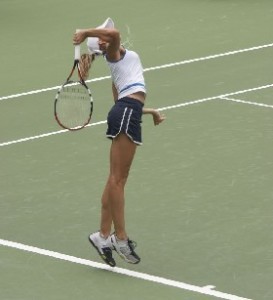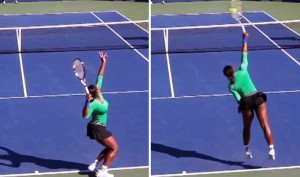Just the other day I was working with one of my tennis players and learned that she was told to keep her wrist straight during her serve when she was growing up. As a result she has managed to create a powerful serve, yet seemingly she has transferred all mobility that should occur in her wrist and torso during her serve, into her lower back. As a result she has been dealing with chronic lower back pain from too much flexion and extension and not enough rotational power.
What does extreme flexion and extension of the back look like in a serve? Well as we can see in the image to the right, there is  increased pressure on the lower back by means of extension and flexion only coming from her lower back. As the serve is one of the hardest techniques to master in tennis, a huge component of it is torso rotation. With this particular case, this player has learned to get all her wrist snap from her lower back…. And the body will only deal with this poor movement technique for so long.
increased pressure on the lower back by means of extension and flexion only coming from her lower back. As the serve is one of the hardest techniques to master in tennis, a huge component of it is torso rotation. With this particular case, this player has learned to get all her wrist snap from her lower back…. And the body will only deal with this poor movement technique for so long.
The solution?
A normal serve will incorporate the rotation of the torso and mobility in the wrist to allow the ball to come back into the service box. We can compare with the image below of what proper torso rotation looks like in a serve. The solution in this instance is of course  retraining how to use the wrist during the serve and how to rotate with the torso throughout the movement.
retraining how to use the wrist during the serve and how to rotate with the torso throughout the movement.
SO…. What muscles do we need to focus on to train proper rotation?
Well the Obliques and Transverse Abdominus muscles predominantly assist in rotation of the torso and are deep to the Rectus Abdominus also known as the six pack. For any athlete who competes in a rotational sport, these muscle groups are very important to activate and strengthen. Doing a standing resistance band rotation is a simple and effective exercise for activating the obliques and transverse abdominus muscles. Here is the proper set up for the standing rotational exercise with a resistance band:
1. Set up parallel to the band placement until the band is taught as shown in the image to the left.
2. Rotate away from the anchor point to fire the obliques and transverse abdominus
3. Return to the midline of your body and repeat
This exercise can be repeated on both right and left sides of the body.
Not a tennis player? No problem…. Rotational movements are not done enough in any given exercise. If you are a runner, you are only traveling in one plane of motion. Consider how much power lives in the torso and consider adding rotational exercises to your normal fitness routine.
Have you ever had lower back pain?
Consider what movements you are doing too much of and not enough of. Consider incorporating three planes of movement to your routine such as walking lunges with a medicine ball rotation and reversing the movement and going backwards.
Have any questions? Hit me up! For any movement you do and you feel pain before, during or after, consider getting checked out or asking your trainer, coach, therapist what you are missing…
Pain is your body giving you a hint to CHANGE something.

